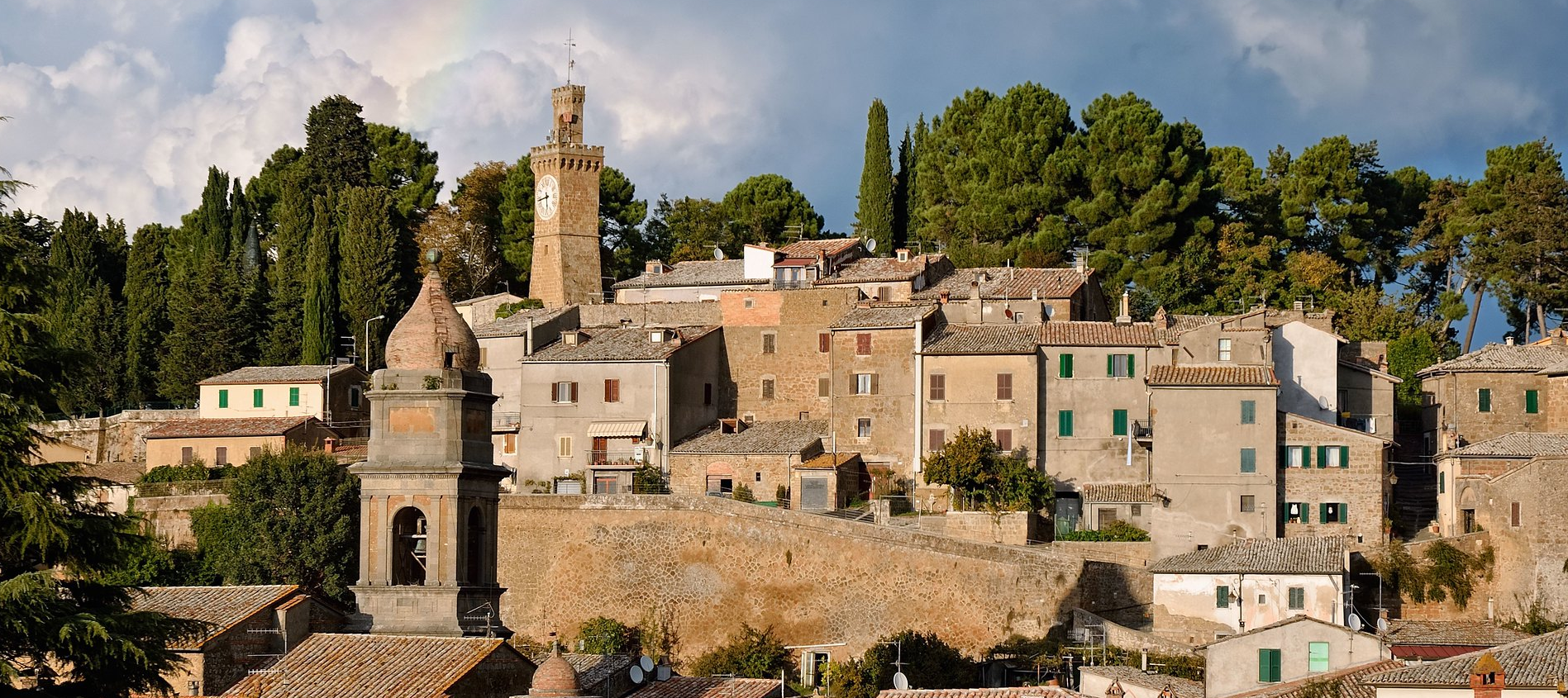
AQUAPENDENTE.
Acquapendente unlike the neighboring towns and cities has neither Etruscan nor Roman origins, probably given its location between the borders of Latium, Umbria and Tuscany, owes its birth and development anterior to the Via Francigena and later the Via Cassia. The earliest historical records date back to 964 when Otto I the Great built a castle there, which later came under the rule of the Swabians.
Later it would enter the dominions of the church thanks to the donation by Matilda of Canossa, for a long time it was disputed between the papacy and the empire, perhaps hence the significance of the rampant lion that occupies its coat of arms, the symbol of an indomitable and victorious people, which would have to pass through the centuries still under the occupation of Frederick Barbarossa, the Sforzas and then returning under the holy see until 1870 when it was annexed to the Italian state.
Although its origins are “recent” when compared with other neighboring places, Acquapendente is nonetheless rich in interesting monuments such as the Cathedral belonging to the Benedictine order and famous because a blood-stained stone from the Holy Sepulcher of Jerusalem is preserved there, according to tradition. The foundation of the basilica is linked to a legend that Matilda of Westphalia, mother of Otto I the Great, on her way from Germany to Rome stopped in Acquapendente, had a premonitory dream and ordered the church to be built. In the medieval period , the basilica was frequented by pilgrims and crusaders, being located on the Via Francigena heading to Rome, it assumed the title of cathedral from 1649.
Other interesting monuments to visit that trace its history divided between empire and church and subjected to various dominations, there is the Church of St. Francis, embellished with a Gothic portal, Palazzo Viscontini built in 1581, the Torre Julia de Jacopo remnant of medieval fortifications, the Clock Tower or also known as “Del Barbarossa,” a trace of imperial power.
But perhaps the real treasures of this place are to be found in its surroundings Torre Alfina and the Monte Rufeno Nature Reserve look like something out of a children’s fairy tale.
The history of the village of Torre Alfina one with that of the castle was born in the early Middle Ages around an existing watchtower.
A chronicle from the’500 dates the founding of the first tower known as the Cassero to the eighth century, but the first historical documents appear in the 1200s, and it is from this period that the history of the castle and the village became intertwined with that of the Monaldeschi della Cervara family. The same artists and craftsmen engaged in the construction of Orvieto Cathedral were used; the Monaldeschi retained ownership until the mid-17th
century, when by inheritance it passed to the Bourbon del Monte family and was later sold to an Antwerp banker Edward Cahen, who totally restored it, transforming it totally in the neo-Gothic style with the help of architect Giuseppe Partini, concealing its medieval authenticity and later Renaissance layers.
A curiosity worth visiting this place for is its late-1800s kitchen, complete with a wonderful French oven and original cookware and furnishings.
The castle is open to the public; hours and information on guided tours can be found at www.castellotorrealfina.com or call 0761445160 – 3202391536.
Be sure to enjoy the ice creams named after this place and known throughout the region.
At the foot of the castle is the village that since 2007 has been recognized among Italy’s most beautiful villages with its narrow streets and stone houses, home to artists who in recent years have also covered the walls of some homes with murals and installations.
We continue our discovery of this fairy-tale territory by heading into the Sasseto Forest, a place that gives off a magic all its own and which, not surprisingly, has been compared to Snow White’s forest by National Geographic. This place offers its visitors a unique and enchanted atmosphere, with the paths winding between rocks and ancient trees.
The Sasseto forest can only be accessed by purchasing a ticket with escort service, this is to preserve the place, (this is not a guided tour) lasting up to two hours.
Access is by reservation priority and also allows entry to the Flower Museum.
Additional services, such as guided tours, can be booked upon request.
And the feeling of walking through a childhood storybook lingers even when we continue our exploration of the Monte Rufeno Nature Reserve, where the forest is located, and reach the old mill, in operation until the 1950s and recently recovered.
But our walk to discover the wonders that this area offers is not over yet, we still have to visit the Flower Museum, each of its interior and exterior spaces is dedicated to many keys with which to approach the theme of flowers, the museum is structured in sections, following a tour route that is not fixed, however, can be built and traveled according to curiosity.
And we move from flowers to the stars by visiting the Astronomical Observatory atop Mount Rufeno, which is home to national astronomical initiatives and the instrumentation allows you to spend a day or rather a night fully immersed in the Universe.
Events and Festivals.
Surely the most famous traditional festival is that of the “Pugnaloni” a popular festival well known in Lazio, where one can admire large mosaics made with fresh flowers, are made in honor of Our Lady of the Flower, which is celebrated on the third Sunday of May.
Festa Contadina this event takes place in d agosta and is a great opportunity to discover the city with the museums also open at night.
Where to Eat.
La Parolina Restaurant
Excellent starred cuisine also vegan and vegetarian
Tuscan Restaurant dall’Aldina
Traditional cuisine with excellent first courses and traditional Tuscan meat dishes


